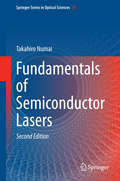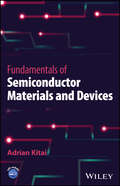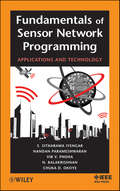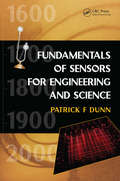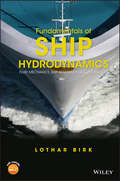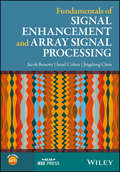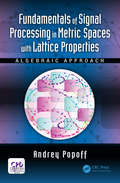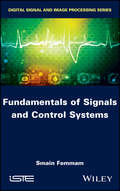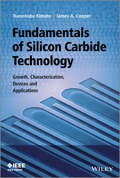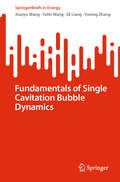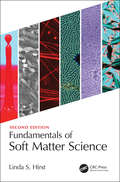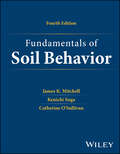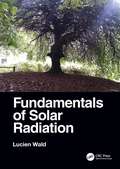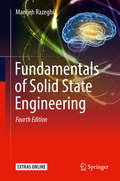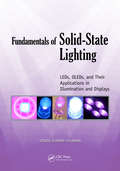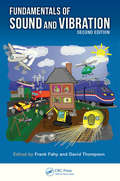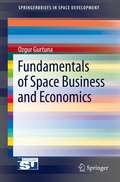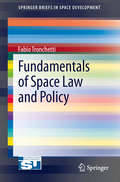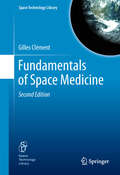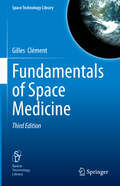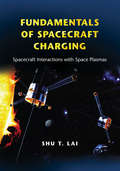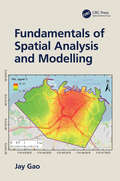- Table View
- List View
Fundamentals of Sedimentology
by Sreepat JainThis new textbook is a modern look at key concepts of sedimentology. With lavish, colorful, and abundant illustrations and easy-to-understand explanations, the book focuses on the concepts required to understand physical, chemical, and biological characteristics of sedimentary rocks and the processes involved in their formation. This includes the transportation, deposition, and transformation of sediments. It also emphasizes how the understanding of sedimentary rocks can be used to interpret all continental, marginal marine, and deep-water oceanic environments. Written with undergraduate-level students in mind, it serves as a primary textbook for the new generation of students.Features Fully up-to-date coverage, using the latest studies in the field of sedimentology. Many colorful illustrations to facilitate the understanding of key concepts. Explanations that are jargon-free and easy to understand for the undergraduate-level reader. Examples to interpret ancient environmental conditions in sediment source areas and depositional sites Written by an experienced researcher and academic who has taught the course at different universities and countries for over 20 years, Fundamentals of Sedimentology is an excellent resource for upper-level undergraduate and graduate students studying Geology, Geomorphology, Physical Geology, and Geography, and it serves as a great reference for entry-level researchers who work in the same fields.
Fundamentals of Semiconductor Lasers
by Takahiro NumaiThis book explains physics under the operating principles of semiconductor lasers in detail based on the experience of the author, dealing with the first manufacturing of phase-shifted DFB-LDs and recent research on transverse modes. The book also bridges a wide gap between journal papers and textbooks, requiring only an undergraduate-level knowledge of electromagnetism and quantum mechanics, and helps readers to understand journal papers where definitions of some technical terms vary, depending on the paper. Two definitions of the photon density in the rate equations and two definitions of the phase-shift in the phase-shifted DFB-LD are explained, and differences in the calculated results are indicated, depending on the definitions. Readers can understand the physics of semiconductor lasers and analytical tools for Fabry-Perot LDs, DFB-LDs, and VCSELs and will be stimulated to develop semiconductor lasers themselves.
Fundamentals of Semiconductor Materials and Devices
by Adrian KitaiGain an introduction to the concepts behind semiconductor materials and devices in this advanced textbook Semiconductors are the foundation of the electronics industry, and are therefore embedded in virtually all modern technology. No engineer or materials scientist can be without an understanding of this essential field. Since semiconductors are also the foundation of solar cells, they play an increasingly critical role in the transition to sustainable technology and promise, as a result, to become even more central in global technological progress. Fundamentals of Semiconductor Materials and Devices is a textbook that presents the advanced principles underlying semiconductors in an accessible and comprehensive way. Combining material from both engineering and physics, it remains grounded throughout in practical applications of semiconductors. Its approach makes it ideal for readers looking to gain a thorough understanding of this ubiquitous technology. Fundamentals of Semiconductor Materials and Devices readers will also find: Questions and exercises to stimulate learning and increase comprehension Introductory chapters detailing the fundamentals of quantum and solid state physics, as well as the foundational principles of semiconductor tech Detailed analysis of topics including flash memory, the quantum dot, two-dimensional semiconductor materials, and more Fundamentals of Semiconductor Materials and Devices is a valuable guide for students and researchers in any area of engineering, physics, or materials science.
Fundamentals of Sensor Network Programming
by N. Balakrishnan Nandan Parameshwaran Vir V. Phoha Chuka D. Okoye S. Sitharama IyengarThis book provides the basics needed to develop sensor network software and supplements it with many case studies covering network applications. It also examines how to develop onboard applications on individual sensors, how to interconnect these sensors, and how to form networks of sensors, although the major aim of this book is to provide foundational principles of developing sensor networking software and critically examine sensor network applications.
Fundamentals of Sensors for Engineering and Science
by Patrick F. DunnFundamentals of Sensors for Engineering and Science is a practical analysis of sensors and measurement, designed to help readers make informed decisions when selecting an appropriate sensor for a given application. Spurred by a growing demand for information on the evolution of modern sensors, this book evaluates current applications to illustrate
Fundamentals of Ship Hydrodynamics: Fluid Mechanics, Ship Resistance and Propulsion
by Lothar BirkFundamentals of Ship Hydrodynamics: Fluid Mechanics, Ship Resistance and Propulsion Lothar Birk, University of New Orleans, USA Bridging the information gap between fluid mechanics and ship hydrodynamics Fundamentals of Ship Hydrodynamics is designed as a textbook for undergraduate education in ship resistance and propulsion. The book provides connections between basic training in calculus and fluid mechanics and the application of hydrodynamics in daily ship design practice. Based on a foundation in fluid mechanics, the origin, use, and limitations of experimental and computational procedures for resistance and propulsion estimates are explained. The book is subdivided into sixty chapters, providing background material for individual lectures. The unabridged treatment of equations and the extensive use of figures and examples enable students to study details at their own pace. Key features: • Covers the range from basic fluid mechanics to applied ship hydrodynamics. • Subdivided into 60 succinct chapters. • In-depth coverage of material enables self-study. • Around 250 figures and tables. Fundamentals of Ship Hydrodynamics is essential reading for students and staff of naval architecture, ocean engineering, and applied physics. The book is also useful for practicing naval architects and engineers who wish to brush up on the basics, prepare for a licensing exam, or expand their knowledge.
Fundamentals of Ship Hydrodynamics: Fluid Mechanics, Ship Resistance and Propulsion
by Lothar BirkFundamentals of Ship Hydrodynamics: Fluid Mechanics, Ship Resistance and Propulsion Lothar Birk, University of New Orleans, USA Bridging the information gap between fluid mechanics and ship hydrodynamics Fundamentals of Ship Hydrodynamics is designed as a textbook for undergraduate education in ship resistance and propulsion. The book provides connections between basic training in calculus and fluid mechanics and the application of hydrodynamics in daily ship design practice. Based on a foundation in fluid mechanics, the origin, use, and limitations of experimental and computational procedures for resistance and propulsion estimates are explained. The book is subdivided into sixty chapters, providing background material for individual lectures. The unabridged treatment of equations and the extensive use of figures and examples enable students to study details at their own pace. Key features: • Covers the range from basic fluid mechanics to applied ship hydrodynamics. • Subdivided into 60 succinct chapters. • In-depth coverage of material enables self-study. • Around 250 figures and tables. Fundamentals of Ship Hydrodynamics is essential reading for students and staff of naval architecture, ocean engineering, and applied physics. The book is also useful for practicing naval architects and engineers who wish to brush up on the basics, prepare for a licensing exam, or expand their knowledge.
Fundamentals of Signal Enhancement and Array Signal Processing (Wiley - IEEE)
by Jacob Benesty Jingdong Chen Israel CohenA comprehensive guide to the theory and practice of signal enhancement and array signal processing, including matlab codes, exercises and instructor and solution manuals Systematically introduces the fundamental principles, theory and applications of signal enhancement and array signal processing in an accessible manner Offers an updated and relevant treatment of array signal processing with rigor and concision Features a companion website that includes presentation files with lecture notes, homework exercises, course projects, solution manuals, instructor manuals, and Matlab codes for the examples in the book
Fundamentals of Signal Processing in Generalized Metric Spaces: Algorithms and Applications
by Andrey PopoffExploring the interrelations between generalized metric spaces, lattice-ordered groups, and order statistics, the book contains a new algebraic approach to Signal Processing Theory. It describes mathematical concepts and results important in the development, analysis, and optimization of signal processing algorithms intended for various applications. The book offers a solution of large-scale Signal Processing Theory problems of increasing both signal processing efficiency under prior uncertainty conditions and signal processing rate that is provided by multiplication-free signal processing algorithms based on lattice-ordered group operations. From simple basic relationships to computer simulation, the text covers a wide range of new mathematical techniques essential for understanding the proposed signal processing algorithms developed for solving the following problems: signal parameter and spectral estimation, signal filtering, detection, classification, and resolution; array signal processing; demultiplexing and demodulation in multi-channel communication systems and multi-station networks; wavelet analysis of 1D/ 2D signals. Along with discussing mathematical aspects, each chapter presents examples illustrating operation of signal processing algorithms developed for various applications. The book helps readers understand relations between known classic and obtained results as well as recent research trends in Signal Processing Theory and its applications, providing all necessary mathematical background concerning lattice-ordered groups to prepare readers for independent work in the marked directions including more advanced research and development.
Fundamentals of Signal Processing in Metric Spaces with Lattice Properties: Algebraic Approach
by Andrey PopoffExploring the interrelation between information theory and signal processing theory, the book contains a new algebraic approach to signal processing theory. Readers will learn this new approach to constructing the unified mathematical fundamentals of both information theory and signal processing theory in addition to new methods of evaluating quality indices of signal processing. The book discusses the methodology of synthesis and analysis of signal processing algorithms providing qualitative increase of signal processing efficiency under parametric and nonparametric prior uncertainty conditions. Examples are included throughout the book to further emphasize new material.
Fundamentals of Signals and Control Systems
by Smain FemmamThe aim of this book is the study of signals and deterministic systems, linear, time-invariant, finite dimensions and causal. A set of useful tools is selected for the automatic and signal processing and methods of representation of dynamic linear systems are exposed, and analysis of their behavior. Finally we discuss the estimation, identification and synthesis of control laws for the purpose of stabilization and regulation. The study of signal characteristics and properties systems and knowledge of mathematical tools and treatment methods and analysis, are lately more and more importance and continue to evolve. The reason is that the current state of technology, particularly electronics and computing, enables the production of very advanced processing systems, effective and less expensive despite the complexity.
Fundamentals of Silicon Carbide Technology: Growth, Characterization, Devices and Applications (Wiley - IEEE)
by Tsunenobu Kimoto James A. CooperA comprehensive introduction and up-to-date reference to SiC power semiconductor devices covering topics from material properties to applications Based on a number of breakthroughs in SiC material science and fabrication technology in the 1980s and 1990s, the first SiC Schottky barrier diodes (SBDs) were released as commercial products in 2001. The SiC SBD market has grown significantly since that time, and SBDs are now used in a variety of power systems, particularly switch-mode power supplies and motor controls. SiC power MOSFETs entered commercial production in 2011, providing rugged, high-efficiency switches for high-frequency power systems. In this wide-ranging book, the authors draw on their considerable experience to present both an introduction to SiC materials, devices, and applications and an in-depth reference for scientists and engineers working in this fast-moving field. Fundamentals of Silicon Carbide Technology covers basic properties of SiC materials, processing technology, theory and analysis of practical devices, and an overview of the most important systems applications. Specifically included are: A complete discussion of SiC material properties, bulk crystal growth, epitaxial growth, device fabrication technology, and characterization techniques. Device physics and operating equations for Schottky diodes, pin diodes, JBS/MPS diodes, JFETs, MOSFETs, BJTs, IGBTs, and thyristors. A survey of power electronics applications, including switch-mode power supplies, motor drives, power converters for electric vehicles, and converters for renewable energy sources. Coverage of special applications, including microwave devices, high-temperature electronics, and rugged sensors. Fully illustrated throughout, the text is written by recognized experts with over 45 years of combined experience in SiC research and development. This book is intended for graduate students and researchers in crystal growth, material science, and semiconductor device technology. The book is also useful for design engineers, application engineers, and product managers in areas such as power supplies, converter and inverter design, electric vehicle technology, high-temperature electronics, sensors, and smart grid technology.
Fundamentals of Single Cavitation Bubble Dynamics (SpringerBriefs in Energy)
by Xiaoyu Wang Yuning Zhang Qi Liang Yufei WangThis brief provides a comprehensive review of the rapidly expanding field of cavitation and bubble dynamics, covering the discussion of bubble dynamics equations, bubble oscillation dynamics, theoretical prediction models of jets, and high-speed photography technology. Among them, the core formulas, important research methods, and typical results related to bubble oscillation and collapse dynamics are systematically and comprehensively introduced. Specifically, in terms of the bubble dynamics equations, several classical dynamic equations utilized to describe the radial motion of the spherical bubble, cylindrical bubble, and the bubble in a droplet are derived and compared. In terms of the bubble oscillation dynamics, based on the perturbation method, multi-scale method, and Laplace transform method, the nonlinear oscillation characteristics of the bubble in free oscillation and driven oscillation are analyzed. In terms of the jet prediction theory, the Kelvin impulse model and various boundary treatment methods are given in detail, and the jet direction, intensity, and spatial sensitivity caused by the bubble collapse near various boundaries are discussed. In terms of the bubble collapse visualization based on the high-speed photography, taking the laser-induced bubble as an example, the system composition, operation process and experimental layout of the high-speed photography experimental platform are introduced, and a large number of typical bubble collapse deformation, jet evolution and shock wave propagation characteristics obtained from experiments are demonstrated. This book is intended for academic researchers and graduate students in fluid dynamics, aiming to consolidate the basic theory, physical mechanism, and latest progress in the field of bubble dynamics.
Fundamentals of Soft Matter Science
by Linda S. HirstThis revised edition continues to provide the most approachable introduction to the structure, characteristics, and everyday applications of soft matter. It begins with a substantially revised overview of the underlying physics and chemistry common to soft materials. Subsequent chapters comprehensively address the different classes of soft materials, from liquid crystals to surfactants, polymers, colloids, and biomaterials, with vivid, full-color illustrations throughout. There are new worked examples throughout, new problems, some deeper mathematical treatment, and new sections on key topics such as diffusion, active matter, liquid crystal defects, surfactant phases and more. • Introduces the science of soft materials, experimental methods used in their study, and wide-ranging applications in everyday life. • Provides brand new worked examples throughout, in addition to expanded chapter problem sets and an updated glossary. • Includes expanded mathematical content and substantially revised introductory chapters. This book will provide a comprehensive introductory resource to both undergraduate and graduate students discovering soft materials for the first time and is aimed at students with an introductory college background in physics, chemistry or materials science.
Fundamentals of Soil Behavior
by Catherine O'Sullivan James K. Mitchell Kenichi SogaAuthoritative and generously illustrated resource covering the many properties of soil and its behavior needed for addressing geotechnical and geoenvironmental engineering projects and problems. The Fourth Edition of Fundamentals of Soil Behavior has been thoroughly updated to provide the latest information on the physical properties of soil and the fundamentals of its behavior, with hundreds of tables and graphs illustrating correlations among composition, classification, state, and static and dynamic properties. Overall, each topic is addressed in a micro-to-macro sequence, considering behaviors at the atomic and/or particle scales to develop understanding of soil properties and behaviors at the macro-scale, which is relevant to engineering practice. This Fourth Edition includes two new chapters on special features of soil behavior and temperature-dependent soil behavior. Other chapters have been substantially updated to include the latest developments in imaging technology, and analysis numerical simulations that have advanced research on the complexities of soil behavior, and recent experimental data. The content has been reviewed, consolidated, and reorganized to more effectively comunicate key information. The text features end-of-chapter questions and problems to aid in seamless reader comprehension and information retention. Updated by true thought leaders in the field, the Fourth Edition of Fundamentals of Soil Behavior includes detailed information on: Soil formation, covering the earth’s crust, the geologic cycle, rock and mineral stability, weathering, and origin of clay minerals and genesis. Soil mineralogy, covering atomic structure, interatomic bonding, secondary bonds, crystal notation, and clay mineral characteristics. Fundamental engineering characterization of soil, covering granular soils and clay minerals. Observing and quantifying soil fabric, covering qualitative and quantitative assessment of soil fabric. Transport of heat, fluid, and electrical current. The fundamentals of volume change, deformation, and strength properties of soils. The impact of time and temperature changes on soil behavior. Providing an understanding of soil behavior, a fundamental requisite to a wide variety of engineering applications including foundation design and construction, earthwork construction, and geotechnical engineering, Fundamentals of Soil Behavior is an essential learning resource for geotechnical and geoenvironmental engineers, geologists, geophysicists, and students studying geotechnical engineering and granular materials.
Fundamentals of Solar Radiation
by Lucien WaldThe sun radiates a tremendous amount of energy, called solar energy or solar radiation, which is the main natural source of energy on the Earth, by far. Because solar radiation is the almost unique supplier of energy to the Earth, it has a primary influence on life and activities on the Earth. The climate is a first example, but there are many others, such as plant growth or human health, or even the design of buildings, the production of energy, notably electrical and thermal, or even aging materials. This book aims to provide simple answers to anyone who has questions about solar radiation. Its ambition is to help by presenting the fundamental elements of the solar radiation received on the ground. The book includes many examples and numerous illustrations, as well as some simple but fairly precise equations to calculate the various elements covered and to reproduce the figures and graphs. The first of the three parts of this book is devoted to the relative geometry between the direction of the sun and an observer on the ground as well as to the solar radiation emitted by the sun and received at the top of the atmosphere. The orbit of the Earth around the sun and the solar declination are described. The concept of time is introduced which is closely linked to the solar cycle and the rotation of the Earth on itself. Equations are given to calculate the solar radiation received on a horizontal or inclined surface located at the top of the atmosphere. The spectral distribution of the extraterrestrial solar radiation is described. The second part of this book addresses how the solar radiation incident at the top of the atmosphere is attenuated and modified in its downward path to the ground. The reflection of the radiation by the ground is presented. The solar radiation received on the ground by a horizontal or inclined collector plane, such as a natural slope or a rooftop, is discussed, as well as its spectral distribution. The variability of the radiation is addressed in relation to the properties of solar radiation estimated from the measurements. The third part deals with direct or indirect measurements of the solar radiation received on the ground over a given integration time (minute, hour, day, or month), whether for total radiation or radiation in a spectral range such as ultraviolet (UV), or daylight, or photosynthetically active radiation (PAR). It also explains how to check the plausibility of the measurements. Fundamentals of Solar Radiation will be a valuable resource to all professionals, engineers, researchers, students, and other practitioners that seek an understanding of solar radiation.
Fundamentals of Solid State Engineering
by Manijeh RazeghiProvides a multidisciplinary introduction to quantum mechanics, solid state physics, advanced devices, and fabrication Covers wide range of topics in the same style and in the same notation Most up to date developments in semiconductor physics and nano-engineering Mathematical derivations are carried through in detail with emphasis on clarity Timely application areas such as biophotonics , bioelectronics
Fundamentals of Solid-State Lighting: LEDs, OLEDs, and Their Applications in Illumination and Displays
by Vinod Kumar KhannaCompared to traditional electrical filaments, arc lamps, and fluorescent lamps, solid-state lighting offers higher efficiency, reliability, and environmentally friendly technology. LED / solid-state lighting is poised to take over conventional lighting due to cost savings-there is pretty much no debate about this. In response to the recent activity
Fundamentals of Sound and Vibration
by David Thompson Frank FahyA Solid Introduction to Sound and Vibration: No Formal Background NeededThis Second Edition of Fundamentals of Sound and Vibration covers the physical, mathematical and technical foundations of sound and vibration at audio frequencies. It presents Acoustics, vibration, and the associated signal processing at a level suitable for graduate stude
Fundamentals of Space Business and Economics
by Ozgur GurtunaThis book provides an overview of key topics related to space business and management. Case studies and an integrative section are included to illustrate the fundamental concepts and to build intuition. Key topics in the field, such as risk management and cost management, are covered in detail.
Fundamentals of Space Law and Policy
by Fabio TronchettiPresents and addresses key space law and policy issues for the benefit of wider informed audiences that wish to acquaint themselves with the fundamentals of the space law field. This brief analyzes in a concise manner the combined influence of space law and policy on international space activities. Read in conjunction with the other books in the Springer 'Space Development' series, it supports a broader understanding of the business, economics, engineering, legal, and procedural aspects of space activities. This book will also give the casual reader as well as experts in the field insight on present and future space law and policy trends, challenges and opportunities.
Fundamentals of Space Medicine
by Gilles ClémentInvestigations in space have led to fundamental discoveries of the human body to the space environment. Gilles Clément has conducted extensive research in this field. This readable text presents the findings from the life science experiments conducted during and after space missions. About 1200 human space flights have been completed to date, including more than 500 astronauts from various countries, for a combined total presence in space of about 90 years. The first edition of this title was published in 2005 (written in 2003 - 2004), and new data is now available from crewmembers participating in long-duration flights on board the International Space Station (ISS). The number of astronauts who have spent six months in orbit has doubled since 2004. On board the ISS, the astronauts use newly developed pharmaceutical countermeasure for bone loss (such as biophosphonates) and state-of-the-art exercise resistive devices against muscle atrophy and cardiovascular deterioration. The ISS life support systems now use advanced closed-loop systems for meeting the needs of a 6-person crew, including recycling urine to water. Some of these new technologies have potential spin-offs for medical (i.e., sedentary life style, obesity) and environmental issues here on Earth. And finally, there are new space research opportunities with the Orion space vehicle that will soon replace the Space Shuttle, the Moon, and Mars space exploration program that is slowly but surely taking shape, and the space tourism sector that has become a reality. The focus on this edition is the ISS, Orion and planetary exploration, and space tourism. This edition also includes more than 20% new material, along with photographs, data, and video clips for Springer Extras!
Fundamentals of Space Medicine (Space Technology Library #47)
by Gilles ClémentThis fundamental 3rd Edition offers a comprehensive overview of performance declines observed in astronauts and cosmonauts throughout various space missions, spanning from Gagarin's flight to the Apollo lunar surface activities, as well as Space Shuttle landings and long-duration stays on board the International Space Station. This evidence forms the basis for identifying risks to crew health and performance during extended space missions, as well as for developing countermeasures to mitigate these risks. In this edition, you'll read how space agencies are currently gearing up for human missions beyond low-Earth orbit, which necessitates addressing numerous physiological, psychological, operational, and scientific challenges prior to establishing bases on the surface of Moon and Mars. The emerging commercial sub-orbital and orbital flight capabilities have captivated both the public and the scientific community. This book also identifies the anticipated hurdles, or "showstoppers," for these space missions and what must be understood to grasp fully the implications and risks for space explorers. Over 650 astronauts from various nations have collectively spent over 184 years in space. Currently, the 72nd expedition crew resides on the International Space Station, maintaining a continuous human presence since 2000. Investigations during this time have explored issues like bone and muscle health, space motion sickness, immune function changes, crew dynamics, and medical challenges such as visual impairment and radiation effects. These studies, including those led by Gilles Clément, have provided valuable insights into human adaptation to space.
Fundamentals of Spacecraft Charging
by Shu T. LaiAs commercial and military spacecraft become more important to the world's economy and defense, and as new scientific and exploratory missions are launched into space, the need for a single comprehensive resource on spacecraft charging becomes increasingly critical. Fundamentals of Spacecraft Charging is the first and only textbook to bring together all the necessary concepts and equations for a complete understanding of the subject. Written by one of the field's leading authorities, this essential reference enables readers to fully grasp the newest ideas and underlying physical mechanisms related to the electrostatic charging of spacecraft in the space environment.Assuming that readers may have little or no background in this area, this complete textbook covers all aspects of the field. The coverage is detailed and thorough, and topics range from secondary and backscattered electrons, spacecraft charging in Maxwellian plasmas, effective mitigation techniques, and potential wells and barriers to operational anomalies, meteors, and neutral gas release. Significant equations are derived from first principles, and abundant examples, exercises, figures, illustrations, and tables are furnished to facilitate comprehension. Fundamentals of Spacecraft Charging is the definitive reference on the physics of spacecraft charging and is suitable for advanced undergraduates, graduate-level students, and professional space researchers.
Fundamentals of Spatial Analysis and Modelling
by Jay GaoThis textbook provides comprehensive and in-depth explanations of all topics related to spatial analysis and spatiotemporal simulation, including how spatial data are acquired, represented digitally, and spatially aggregated. Also features the nature of space and how it is measured. Descriptive, explanatory, and inferential analyses are covered for point, line, and area data. It captures the latest developments in spatiotemporal simulation with cellular automata and agent-based modelling, and through practical examples discusses how spatial analysis and modelling can be implemented in different computing platforms. A much-needed textbook for a course at upper undergraduate and postgraduate levels.

